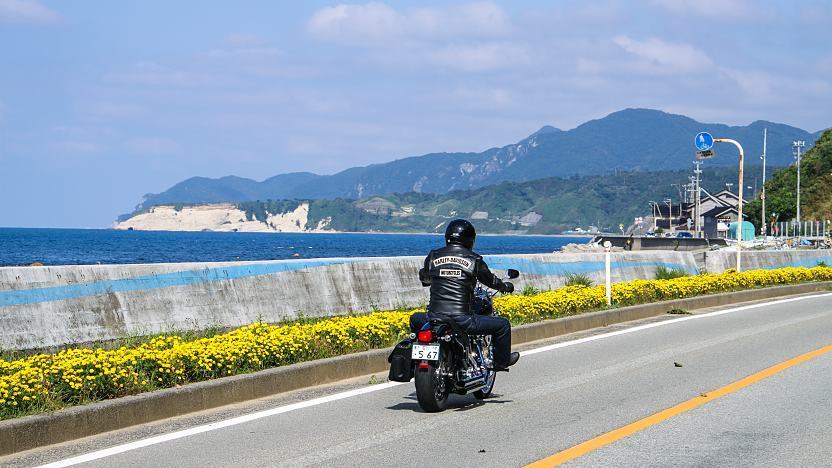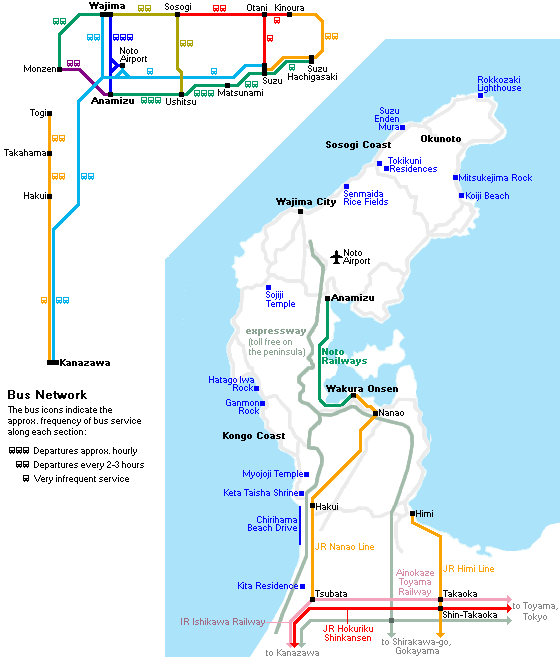Okunoto Coast

Okunoto (奥能登, "Inner Noto") is the region that comprises the northern part of the Noto Peninsula around its tip. The region is remote and rural, and the discontinuation of the train lines that had served the area for decades left the Okunoto region even more isolated. Wajima is the region's main city and is located about 25 kilometers from the peninsula's tip.
The Okunoto part of the peninsula area has a calmer inner coast that faces the mainland and a rougher outer coast that is exposed to the Sea of Japan. The inner coast has fishing villages and small boats that populate the scenery, whereas the outer coast provides dramatic views of rugged natural terrain. A two and a half kilometer stretch along the outer coast, called the Sosogi Coast, is particularly scenic.
The most famous sight along the outer coast is Senmaida, a hillside of terraced rice fields along the Sea of Japan. There are over 2000 small rice fields that must be worked by hand, and senmaida literally means "a thousand rice fields". Located just along the main road, Senmaida is easily accessible and has a parking lot and visitor center for cars and tour buses.

A highlight along the inner coast is the Mitsukejima rock. Mitsukejima means "found island", and according to legend it was first discovered and named over a thousand years ago by Kobo Daishi, one of the most important figures of Japanese Buddhism. The island rises about 30 meters into the air, towering over travelers who walk along the rock path to get a closer look. A bell nearby is said to bring good luck to lovers who ring it together.
About three kilometers away another group of interesting rock formations can be found at the Koiji Beach, literally "The Beach of the Path to Love". Despite the name, there is a sad story associated with the area. Hundreds of years ago, two lovers met a tragic end in the waters beside the beach. When one lover was deceived into drowning by a jealous suitor, the other cast herself into the water to die as well. By ringing the bell at Mitsukejima, perhaps visitors will enjoy more luck in their romances.

At the very tip of the peninsula is Cape Rokkozaki with the pretty Rokkozaki Lighthouse, reached in a ten minute walk from the nearest parking lot and bus stop. Unfortunately, visitors are not able to enter the Meiji Period building, and can only observe it from outside. From the cape there are views onto the water, and signs indicate directions and distances to major Asian cities.
The Okunoto salt farms, or enden in Japanese, are unique to the Okunoto area. Hundreds of years ago, salt was gathered from the ocean by spreading seawater on fields of sand and then gathering the salt after the water evaporated. This tradition is still practiced at a few locations in Okunoto. The Suzu Enden Mura has a functioning salt farm that is open to the public, as well as displays about salt. Nearby, a bit inland, are the Tokikuni Residences.

Getting there and around
The Okunoto area is best explored by rental car or other forms of private transportation. Buses run along the entire coast, stopping at all the attractions mentioned above, however, service is infrequent and complicated, and multiple transfers of buses are required along the way.
The following bus stops are located nearby the corresponding attractions of the Okunoto coast: Shirayone Senmaida (白米千枚田) bus stop for the Senmaida rice fields, Mitsukejima-guchi (見附島口) bus stop for Mitsukejima, Koiji-hama (恋路浜) bus stop for Koiji Beach, Noroshi (狼煙) bus stop for Rokkozaki Lighthouse, and Suzu Enden Mura (珠洲塩田村) bus stop for Suzu Enden Mura.
How to get to and around the Noto Peninsula

Hours and Fees
Suzu Enden Mura
Hours
Closed
Admission
Typical Visit Duration
Questions? Ask in our forum.


